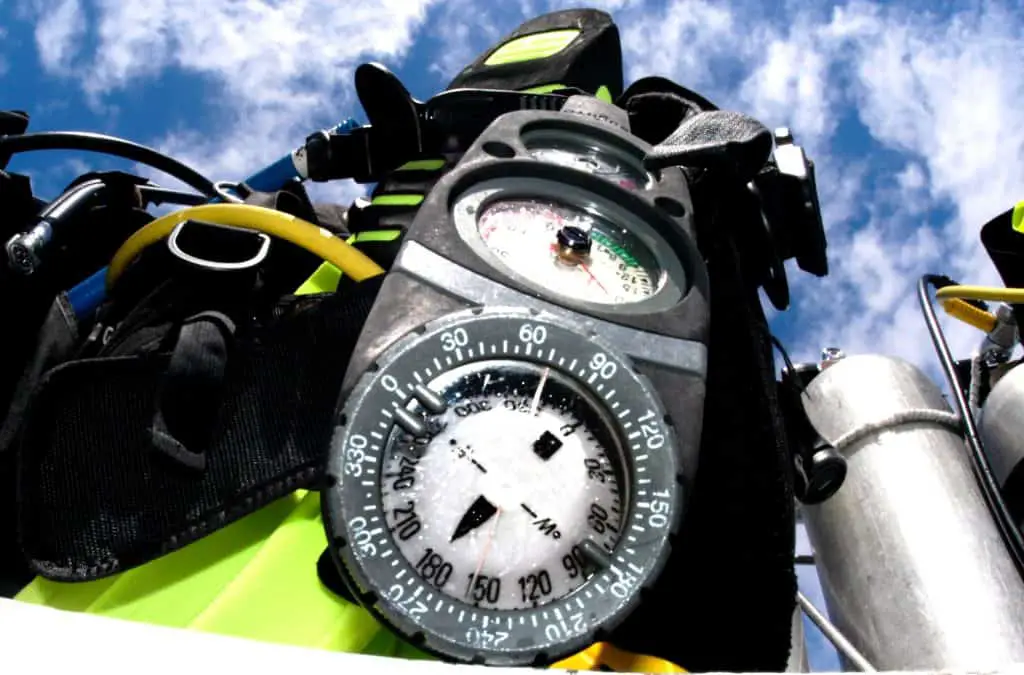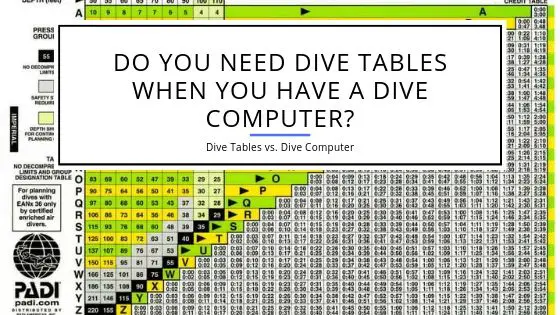Do you need to know Dive Tables when you have a Dive Computer?
Before dive computers became a common sight in the scuba scene, the only reliable way to calculate safe dive times were dive tables. Dive tables were initially created for military use in order to ensure that scuba divers don’t suffer from decompression sickness.
Do you need dive tables when you have a dive computer? Technically you don’t. However, your dive computer could break and you do want to be able to plan your dive based on dive tables so you have a fallback in that case! It’s a good idea to have that capability in case technology does not work!
Dive Table and Dive Computer Basics
Dive tables are set up under the assumption that the scuba diver stayed at the maximum depth for the entire dive. The nitrogen absorption is calculated based on these parameters.
Dive computers work differently. They record the actual time and depth of a scuba diver and then calculate the nitrogen absorption based on these actual values. This higher level of accuracy results in longer dive times and shorter surface intervals.
How to Read Dive Tables
The typical recreational dive planner will let you estimate for a given depth how long you can dive without having to do a decompression stop. Let’s take for example that you will dive with Air/Nitrox with 36% O2. You dive down to 70 feet. You will have a maximum time of 75 minutes (assuming you have enough Nitrox in your cylinder) without a deco stop. However, if you stay longer than 63 minutes you’ll need to add a safety stop.
The recreational dive planner does assume that you’ll spend the entire time down at those depths. That’s not true as you have to descend and ascend so your bottom time is much shorter. Anyway, let’s say you were scuba diving to 70 feet for 30 minutes. If you look at the dive table, you’ll see that this puts you into the pressure group ‘I’.
Pressure Groups for Repetitive Diving
If you want to then perform a second dive, you have to remember your pressure group. Repeat dives require different calculations as you have to consider the residual nitrogen in your body.
Let’s assume you’ll have a surface interval of 30 minutes. You were in pressure group ‘I’ after your first dive. Slide your finger across the ‘I’ row to the right of the table until you find your surface time interval reading that matches your time out of water.
In this specific case, the range you’ll find is ‘0:27 – 0:34’. If you now move your eye down to the bottom of that column, you’ll see that you will be in pressure group ‘E’ after those 30 minutes. This is important to know as a starting point for your repetitive dive.
Reading RNT and ABT
If you plan your repetitive dive, you have to flip the dive table to the table printed on the back. This table is used for repetitive dives and will provide you with the ‘Residual Nitrogen Time‘, short RNT. Again, let’s take the previous numbers and look at the EANx36 table for repetitive dives.
You were in pressure group ‘E’ after your first dive and plan to dive to 50 feet on your second dive after a surface interval of around 30 minutes. The Residual Nitrogen Time (RNT) reads at 33 minutes and your Actual Bottom Time (ABT) reads at 187 minutes.
You have to remember those values to go back to the first table. The residual nitrogen time basically tells you by how much time you have to reduce the time from the first time if it’s your second dive. ABT is your adjusted/new no-decompression limit (NDL) or adjusted bottom time where you don’t require a decompression stop on your way up.
For example, if your second dive is to a depth of 50 feet and you plan to stay at that depth for a dive time of 37 minutes. If it was your first dive, you’d end up in pressure group ‘F’ when scuba diving EANx36. However, as it’s your second dive, you have to add the residual nitrogen time of 33 minutes to your 37 minute dive time. That puts you at 70 minutes at 50 feet, which results in pressure group ‘M’. Quite a different story now with regards to your nitrogen saturation.
If you plan on another repetitive dive you can then take that pressure group and your surface interval and calculate residual nitrogen time and ABT and perform the calculations as outlined for the second dive above. Take the surface interval into consideration and then figure out your new pressure group for the next dive.
The video below gives you an introduction on how to read and work with the PADI recreational dive tables.
Different Bottom Time Results
The differences in the calculations can be quite astonishing. If you for example take a dive at 120 feet. Based on dive tables you can stay down for around 10 minutes as the assumption is that you spend the whole dive at 120 feet. A dive computer will take the actual values into consideration and you’ll end up with a bottom time of around 30 minutes (or so). Quite a difference…
In any typical scenario, the safety margins with dive computers are much higher than with dive tables as the parameters used for the calculations are the actual values, and as the calculations are continuously being performed. With a dive table, you typically have to figure out beforehand how long you can stay at what depth while the dive computer adjusts the nitrogen absorption calculations on the fly. It can then provide information about decompression stops on the way up if necessary.
One of the big drawbacks of both dive tables and scuba computers [Have a look at the top-rated dive computers for new divers!] is that the calculations are based on mathematical models. The diver’s physical data like weight, etc. are not taken into consideration. This means that neither method completely eliminates the risk of decompression sickness. It can be safely assumed that one of the next generations of dive computers will take these physical parameters into consideration for even safer and more accurate calculations.
Many dive computers allow to adjust their algorithm with safety settings. It would always be a wise choice to use a safer setting rather than an aggressive setting to calculate nitrogen absorption.

Is a dive computer with integrated air measuring right for you? Find the best dive computers with air-integration!
Deepest Dive First – Still the Rule?
When relying on dive tables it was always a rule to have the deepest dive first and shallow dives following later. With modern dive computers, this rule is no longer required.
Diving computers can calculate reverse dive profiles exactly and the same as traditional dive profiles. However, when relying on dive tables, you can’t do a reverse dive profile. When you do a shallow dive first and follow that with a deep dive, you either end up with a decompression stop or you couldn’t even calculate your bottom time as the dive tables won’t support this scenario. You can safely dive such a profile if you use a dive computer as it will calculate correctly.
Many new scuba divers wonder why they even should care about dive tables when the dive computer does all the work. This is true to some extent but it can also be dangerous to not know the basics and not know how to use a dive table.
Why even consider dive tables?
Unfortunately, dive computers, like any other device, can break or in the simplest case, run out of battery. If at that time scuba divers don’t know how to use a dive table, they’ll be stranded until your computer is fixed or the battery is replaced. A diver knowing how to use dive tables can use this method as a backup in case the dive computer stops working.
A counterargument might be in this case that you could have a backup dive computer that can be used. While this is true, it also has a risk factor involved. The backup computer does not know anything about your previous dives and thus might end up with calculations that could put you at risk for decompression sickness. It will be safer, in that case, to use dive tables as you can adjust those to take your previous dives into consideration.
Best Practice – Be able to use both
A best practice is to use a scuba computer as your main calculation tool and dive tables as your backup. A personal diving computer allows you to keep a lot of your dives. Many of the modern dive computers can transfer that log to a computer and you can model future dives based on that historic data.
The capabilities offered by such a personal scuba computer are infinitely higher than what you could accomplish with the use of dive tables and manual logs. However, to keep your dive experience safe you should have a basic understanding of the models used to calculate dive times.
Dive Computers can do what Dive Tables can’t
Dive computers not only made it more convenient to dive but also offer dive profiles that were practically not possible by only using dive tables. Well, they were possible but the time it took to plan a dive was enormous.
Many modern dive computers for example allow switching gases on the fly so you can use different nitrox mixes or use air and nitrox in a single dive to maximize your bottom time [Does diving with Nitrox affect your bottom time?]. Higher-end models also allow measuring air consumption to further maximize and optimize any dive.
Conclusion
Dive computers are essential to the safety of the sport. Over time they became reliable devices that maximize bottom time while providing higher margins of safety for the diver.
No diver should go scuba diving without a personal scuba computer. However, to always be on the safe side and to understand what a dive computer is really doing, it is highly recommended to know how to use dive tables. One never knows when it becomes necessary to use them.
Enjoy your diving and go get a dive computer if you don’t have one. Check out our guide to the best dive computers so you can find the best device for your budget and scuba diving needs!
Image Credit: https://www.flickr.com/photos/61438018@N00/2279256524

